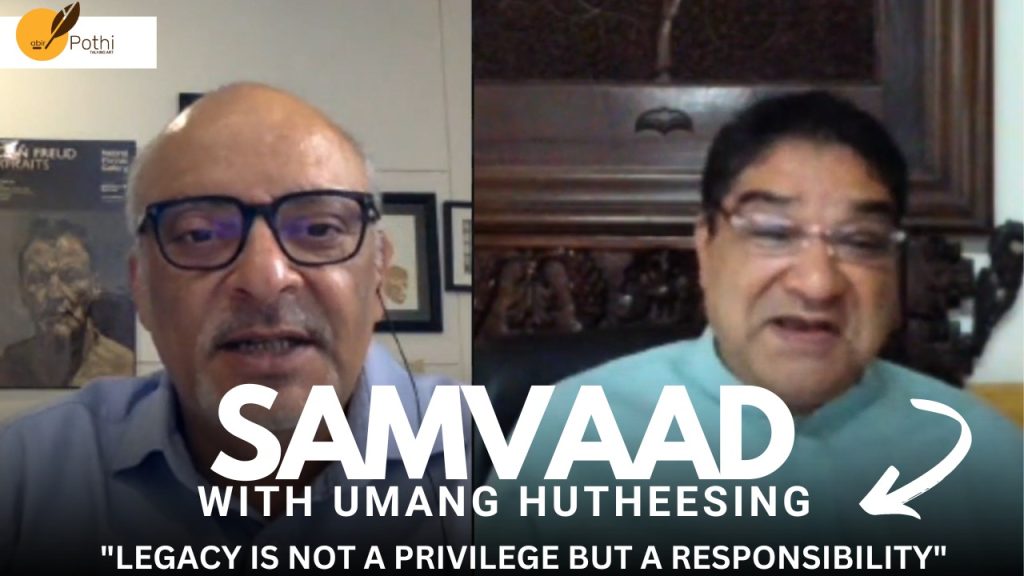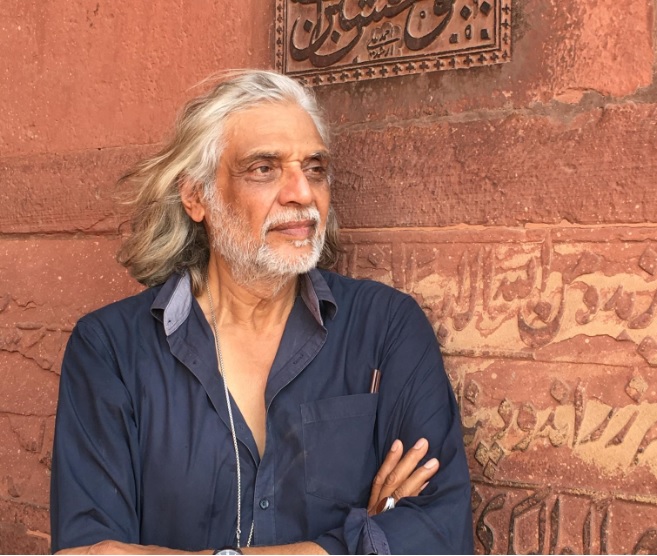Welcome to Samvaad, where art meets conversation, and inspiration knows no bounds. Here we engage in insightful conversations with eminent personalities from the art fraternity. Through Samvaad, Abir Pothi aims to create a platform for thought-provoking discussions, providing readers with an exclusive glimpse into the creative processes, inspirations, and experiences of these creative individuals. From curating groundbreaking exhibitions to pushing the boundaries of artistic expression, our interviews shed light on the diverse perspectives and contributions of these art luminaries. Samvaad is your ticket to connect with the visionaries who breathe life into the art world, offering unique insights and behind-the-scenes glimpses into their fascinating journeys.
This is part 5 of the Samvaad between Nidheesh Tyagi from Abir and Umang Hutheesing, the founder and president of the Hutheesing heritage foundation. Umang Hutheesing is on the governing board of the Ahmedabad Education Society, a managing trustee of the Hutheesing Visual Art Centre, and most importantly is the president and fifth generation of Hutheesing to manage the Hutheesing Design Company and Studio from the very same historic location, Jaising bhai-ni-wadi. He is also the founder and president of the Hutheesing heritage foundation which has restored the Hutheesing Haveli and preserves the Hutheesing art collection. He has collaborated with the international foundation Musée Yves Saint Laurent in Paris and the National Museum of Bahrain, the Baroque Museum in Mexico, the Miho Museum in Japan, and the Chhatrapati Shivaji Vaastu Sangrahalya in Mumbai, where he has exhibited over 300 pieces showcasing the cultural heritage designed by him from the Hutheesing collection.
Nidheesh: you are so contemporary, so relevant, and forward-looking. I mean that’s the other thing about your family and all the philanthropists from Ahmedabad, they were also forward-looking as against the other cities of India. What they came up with, management, space technology, and design other things of public interest.
Umang: yes and when we think of it, India became a nation from Ahmedabad. Sabarmati ashram is built here and the Dandi march started from here Gandhi said I’ll not return until I get Swaraj. From there to Indira Gandhi who loved the Hutheesings for a long period, my elder grandmother was Nehru’s real sister, Rajiv Gandhi was born in our house from there to Narendra Modi addressing the nation from Hutheesing Haveli from Ahmedabad. Ahmedabad plays an important role in shaping India and therefore, IIM, NID, School of Architecture, ISRO. The family with the vision that we’re not just going to build a company, but we’re going to build a country. Supporting the vision of our political leaders.
Nidheesh: and that too with being romantic, there was always a pragmatic approach.
Umang: I should say, we gave the vision and got support from the political leaders because we were connected and built these in Ahmedabad. The vision came from here; the political will came from there. Well, the vision was here, and the resources were here.
Nidheesh: true, and that’s why I was saying that this was so pragmatic in approach and not just a romantic kind of an approach not just a romantic kind of response to things but with a very good cause but also very measured in what they were doing.
Umang: I think that generation, the five generations that understood the austerities and lived under the British and imperial atrocities, freedom realized to build a modern and powerful India. And, Willing to make personal sacrifices because they were very simple in their existence in the Gandhian structure, I am talking about the Gandhian structure, not the Nehruvian, I am talking about Mahatma Gandhi. And, you know we were not political families whether it was Morarji Desai or L.K. Advani or my family supported everybody and people forget. Most of the powerful people have been elected from Gujarat. Here right now, Jai Shankar and Narendra Modi are all from Gujarat. Jaishankar Prasad got a lok sabha seat from Gujarat, Ahmed Patel, Gujarat. Congress or BJP the backbone of visionaries came from Gujarat.
Nidheesh: politics is a kind of very complex subject and Abir Pothi is largely.
Umang: no, I am not talking in terms of politics I am talking about the political support built in Gujarat.
Nidheesh: yeah absolutely, the idea was coming up..
Umang: yes you can’t build ISRO and do space research if the government doesn’t support you. So, to do all these things you need to have vision resources and amenities but if political support doesn’t come you can’t execute it.
Nidheesh: true. Tell us about your own art journey. What happened after you came back?
Umang: so, after I came back, then of course I joined the family business in industry which was in textiles, but again as India grew, I was getting bored with industrial production. I felt industrial production becoming too boring and mechanized. I was interested in something which was bought ancient and that was hand craftmanship and that’s where art and crafts come in. I mean today, now you are going into a new age territory, but it was a new hand-craftsmanship that I enjoy, and Hutheesing Design company was built to support craftsmen. And that has been long dormant, so started to look into that. Started restoring the Hutheesing collection put them in perspective, the Hutheesing Haveli is where the design women started working, and so many art and literature things happened. So, that process got me involved with a lot of craftspeople, artists, and poets. I mean art is not limited to painting.
Nidheesh: the whole creative space basically.
Umang: the arts! They’re all interwoven together. And of course, getting involved with the Hutheesing Centre and trying to bring my own experiences in the global arena to Ahmedabad and the young artists of India. Through an institution, not as an individual.
Nidheesh: but your own practice of art, what happened to that?
Umang: I do paint, but I do it more as a personal hobby. But, my design things became a metamorphosis in textile. I do run a label of my own, you know, a textile label. God has been kind and my work has worked very well. And we’re the only design firm in Asia to have three hundred pieces designed and crafted for us in world museums. No other person has sent them. And I am talking about the top-notch museums of the world. Which have handcrafted pieces of us in their collection. So, that was a very interesting journey.
Nidheesh: what was the thought and idea? I mean conceptually.
Umang: after travelling and living so much abroad, one realizes, see in India we don’t have a museum culture. The culture of India and art of India exist at home, and we’re continuously limited. But, museums are a very important part. What are museums? People don’t understand it. In a museum nothing is for sale, a museum is a record to preserve humanity’s achievements. And to have these pieces at world museums, it shows the beautiful living heritage of our craftsmen. Recreated and presented to the world to show we’re not dead, we’re alive, and we will take it forward. This is our contribution to humanity. Making commercial sales is easy, but making for museums is not easy.
Nidheesh: yes. It’s a huge kind of responsibility.
Umang: very difficult. I don’t work with the choreographers who do the fashion show, I work with the museum curators to make a collection that they proudly present in their museums. It’s different. But you take it to that level of perfection.
Transcribed by Abhishek Dixit






